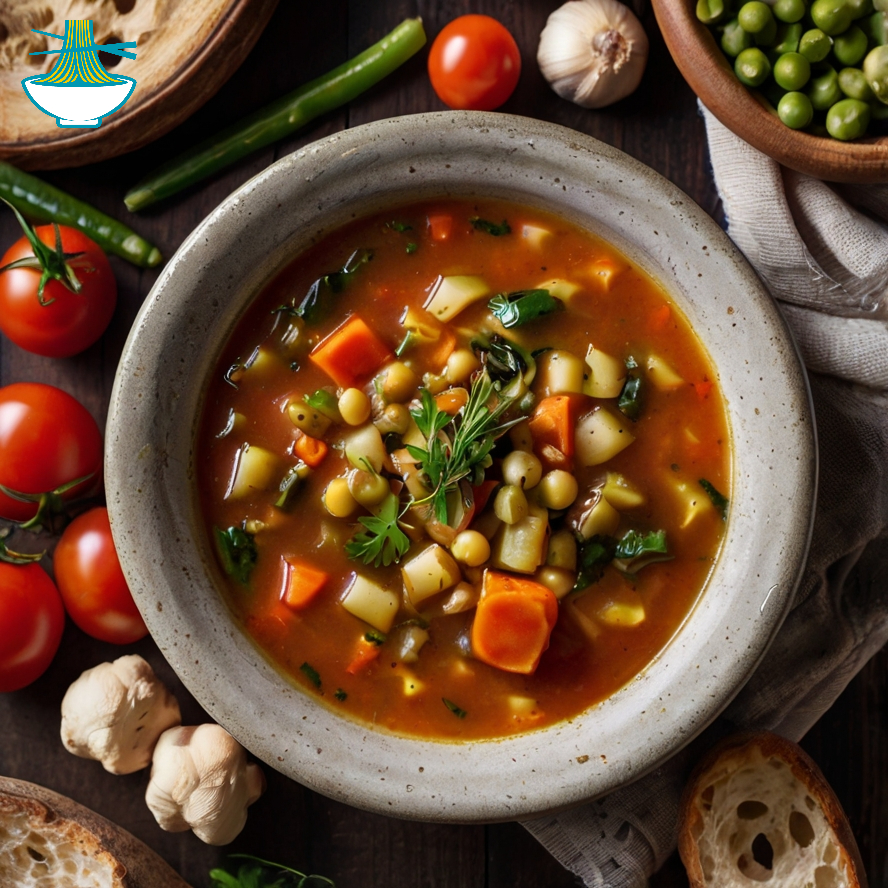Minestra is a classic Maltese vegetable soup brimming with the goodness of fresh vegetables and pulses like beans and lentils. This wholesome dish provides an excellent source of dietary fiber, supporting digestive health and promoting a feeling of fullness. The variety of vegetables delivers essential vitamins such as A and C, boosting immunity and skin health, while the pulses provide plant-based protein, making it a satisfying and nutritious meal. However, the soup’s sodium content can be high if processed ingredients or added salt are used excessively. Enjoy Minestra as a comforting, nutrient-packed dish perfect for any season.
Ingredients:
- 2 tbsp olive oil
- 1 large onion, chopped
- 2 garlic cloves, minced
- 2 carrots, diced
- 2 celery stalks, diced
- 1 cup chopped pumpkin or butternut squash
- 2 medium potatoes, peeled and cubed
- 1 cup fresh or frozen peas
- 1/2 cup dried lentils or split peas, rinsed
- 1 can (400g) diced tomatoes
- 1.5 liters vegetable stock
- 1 tsp dried thyme
- 1 bay leaf
- Salt and pepper to taste
- Fresh parsley, chopped (for garnish)
Healthy Alternatives: For those with dietary restrictions or preferences, you can substitute various ingredients in this Minestra recipe. Here are some suggestions:
- For a vegan version: Instead of using vegetable stock that may contain animal products, use a homemade or store-bought vegetable broth that is clearly labeled vegan.
- For gluten-free diets: Ensure that the vegetable stock and any processed ingredients used are gluten-free. Also, serve the soup with gluten-free bread or omit the bread entirely for a low-carb option.
- For nut-free diets: If you want to add a bit of crunch, try seeds like sunflower or pumpkin seeds instead of nuts.
- For dairy-free diets: This recipe is already dairy-free, but if you want to add a creamy texture, use coconut cream or almond milk instead of any dairy-based creams.
Instructions:
- Heat the olive oil in a large pot over medium heat. This will create the base for sautéing the vegetables and herbs, infusing the soup with rich flavor.
- Add the chopped onion and minced garlic to the pot. Sauté them for about 3-4 minutes or until the onion becomes soft and translucent, and the garlic releases its aromatic fragrance. Stir occasionally to prevent burning.
- Incorporate the diced carrots, celery stalks, chopped pumpkin or butternut squash, and peeled potatoes into the pot. Stir everything together and cook for 5 minutes. The vegetables should begin to soften, and their natural sweetness will start to emerge.
- Add the dried lentils or split peas along with the diced tomatoes and season with dried thyme and a bay leaf. Stir to combine, ensuring that the spices coat the vegetables evenly.
- Pour in the vegetable stock and bring the mixture to a boil. Stir occasionally to ensure all ingredients are well mixed. The boiling will help bring out the flavors of the vegetables and herbs.
- Once boiling, reduce the heat to low. Cover the pot with a lid and allow the soup to simmer for about 30-40 minutes. Stir occasionally to ensure that the lentils and vegetables are cooking evenly and the flavors are merging.
- Add the peas during the final 10 minutes of cooking. This will allow the peas to remain bright and tender without overcooking them. Stir them into the soup, ensuring they are evenly distributed.
- Season with salt and pepper to taste. Taste the soup and adjust the seasoning as needed to balance the flavors. Be cautious with salt, especially if you're using a pre-made vegetable stock that might contain salt.
- Remove the bay leaf before serving. This is essential, as the bay leaf is for flavoring, and it should not be eaten.
- Garnish with fresh parsley just before serving to add a pop of color and freshness to the soup. You can also serve your Minestra hot with crusty bread for an extra comforting meal.
Enjoy your Minestra hot, nutrient-packed, and perfect for any season!
Serving Suggestions: Minestra is versatile and can be served in various ways:
- As a main dish: To make it a heartier main course, add plant-based proteins like tofu, tempeh, or chickpeas. You can also add animal proteins like grilled chicken or turkey for a meat-based version.
- With crusty bread: The soup is delicious when served with warm, crusty bread on the side to soak up the flavors.
- As a side dish: It can be served alongside a protein like roasted chicken or grilled fish for a balanced meal.
- Topped with greens: For added freshness, garnish with chopped spinach, arugula, or fresh basil.
Storage Tips: To store Minestra properly, follow these guidelines:
- In the refrigerator: Store the soup in an airtight container for up to 3-4 days. Reheat thoroughly before serving.
- In the freezer: Minestra can be frozen for up to 3 months. Make sure to let the soup cool completely before transferring it to freezer-safe containers or bags. To reheat, defrost in the fridge overnight and then warm on the stove.
- To prevent spoilage: Avoid adding fresh herbs like parsley or basil before storing; add them just before serving.
Frequently Asked Questions (FAQ):
Can I add meat to Minestra?
- Yes, you can add meat to this soup. Common options include chicken, beef, or turkey. For a heartier version, add cooked chicken breast or ground beef along with the vegetables and lentils. Simply sauté the meat along with the onions and garlic before adding the rest of the ingredients.
Can I use chicken stock instead of vegetable stock?
- Yes, you can use chicken stock in place of vegetable stock if you prefer a richer flavor. However, if you’re following a vegetarian or vegan diet, it’s best to stick with vegetable stock.
What is the best way to reduce the sodium content in this soup?
- To lower the sodium levels, use low-sodium vegetable or chicken stock. Additionally, be mindful of the amount of salt you add while seasoning and opt for fresh herbs and spices for flavoring.
How can I make Minestra thicker or lighter?
- To make the soup thicker, blend a portion of the vegetables or add a small amount of mashed potatoes. If you prefer a lighter consistency, simply add more vegetable stock and reduce the cooking time to allow some of the vegetables to stay intact.
Is Minestra suitable for young children?
- Yes, Minestra can be a great option for young children. It’s a nutrient-dense soup packed with vitamins and minerals. You may want to ensure that the vegetables are soft and cooked thoroughly for easier chewing, and avoid adding too much salt.
How should I store Minestra?
- Store Minestra in an airtight container in the refrigerator for up to 3-4 days. It can also be frozen for up to 3 months. Make sure to cool the soup completely before refrigerating or freezing.
Is Minestra suitable for a low-sodium diet?
- Yes, Minestra can be adjusted to fit a low-sodium diet. Use low-sodium vegetable stock, reduce the added salt, and be cautious with any canned ingredients, as they can often contain high amounts of sodium.
Can I replace any ingredients to make Minestra vegan-friendly?
- Yes, this recipe is easily adaptable for vegan diets. Simply use vegetable stock and ensure that no animal products are used in any of the processed ingredients. You can also add plant-based proteins like tofu or chickpeas for extra protein.

Nutritional Values and Benefits
2 tbsp Olive Oil (30g)
- Calories: 240
- Fat: 28g
Benefits: Olive oil is rich in heart-healthy monounsaturated fats and antioxidants, supporting cardiovascular health.
1 Large Onion (150g)
- Calories: 60
- Carbohydrates: 14g
- Vitamins: Vitamin C (10% DV), Vitamin B6 (11% DV)
Benefits: Onions are high in antioxidants and compounds that may boost heart health and immune function.
2 Garlic Cloves (6g)
- Calories: 10
- Carbohydrates: 2g
Benefits: Garlic contains allicin, which supports immune health and has anti-inflammatory properties.
2 Carrots (150g)
- Calories: 52
- Carbohydrates: 12g
- Vitamins: Vitamin A (300% DV), Vitamin K (10% DV)
Benefits: Carrots are a great source of beta-carotene, promoting eye health and boosting immunity.
2 Celery Stalks (80g)
- Calories: 14
- Carbohydrates: 3g
- Vitamins: Vitamin K (40% DV), Folate (8% DV)
Benefits: Celery supports hydration and provides antioxidants that reduce inflammation.
1 Cup Chopped Pumpkin (116g)
- Calories: 30
- Carbohydrates: 8g
- Vitamins: Vitamin A (200% DV), Vitamin C (15% DV)
Benefits: Pumpkin is rich in antioxidants and promotes healthy vision and immunity.
2 Medium Potatoes (300g)
- Calories: 260
- Carbohydrates: 60g
Benefits: Potatoes are a good source of energy and potassium, supporting muscle function and hydration.
1 Cup Fresh or Frozen Peas (160g)
- Calories: 62
- Protein: 4g
- Vitamins: Vitamin C (35% DV), Vitamin K (25% DV)
Benefits: Peas are high in fiber and protein, supporting digestion and muscle health.
1/2 Cup Dried Lentils (100g)
- Calories: 350
- Protein: 25g
- Carbohydrates: 60g
Benefits: Lentils are an excellent source of plant-based protein, iron, and fiber, promoting heart and digestive health.
1 Can Diced Tomatoes (400g)
- Calories: 80
- Carbohydrates: 16g
- Vitamins: Vitamin C (30% DV), Vitamin A (20% DV)
Benefits: Tomatoes are rich in antioxidants like lycopene, supporting skin health and reducing inflammation.
1.5 Liters Vegetable Stock
- Calories: 20
- Sodium: Varies
Benefits: Adds flavor to the soup, but sodium levels should be monitored to maintain heart health.
Nutritional Information per Serving: For a better understanding of the nutritional value, here’s a more detailed breakdown of the ingredients in a single serving of Minestra (approximate values):
- Calories: 300-350 kcal (depending on the serving size and any added proteins)
- Protein: 15g (from lentils, peas, and added proteins if any)
- Fat: 10g (mainly from olive oil, which contains heart-healthy fats)
- Carbohydrates: 45g (from potatoes, carrots, and peas)
- Fiber: 10g (from lentils, peas, and vegetables)
- Sodium: Varies (depends on the vegetable stock used)
Additional Health Benefits: The ingredients in Minestra offer a range of health benefits, especially for digestive and heart health:
- Peas: Rich in dietary fiber and plant-based protein, peas help support digestive health by promoting regular bowel movements. They are also beneficial for heart health by reducing cholesterol levels.
- Lentils: Packed with fiber, lentils support healthy digestion and can lower the risk of heart disease. They also provide iron, which is essential for maintaining healthy blood cells.
- Pumpkin: High in beta-carotene, pumpkin promotes healthy vision and immune function. It also helps to reduce inflammation in the body, supporting overall health.
- Olive Oil: The monounsaturated fats in olive oil support heart health by lowering bad cholesterol levels. It also contains antioxidants that have anti-inflammatory properties.
Summary
Minestra is a hearty and nutritious Maltese vegetable soup that combines the goodness of fresh vegetables and protein-rich pulses. Packed with essential vitamins, minerals, and fiber, this soup is an excellent choice for a wholesome meal. Enjoy its comforting taste while reaping the benefits of its nutrient-dense ingredients.


Comments